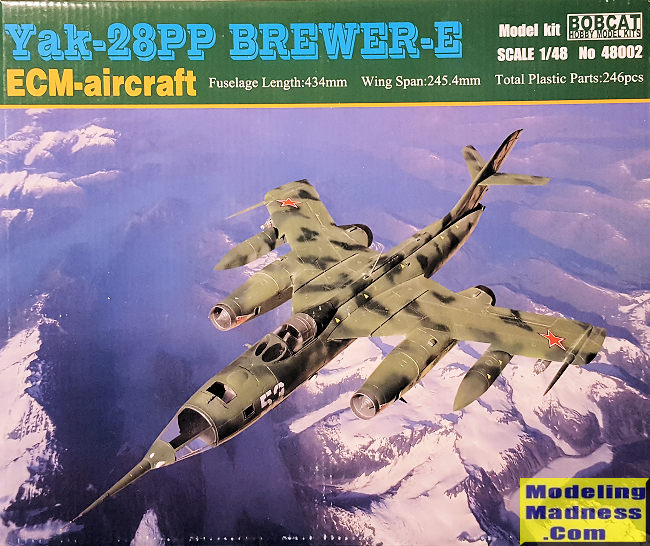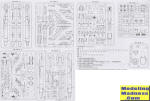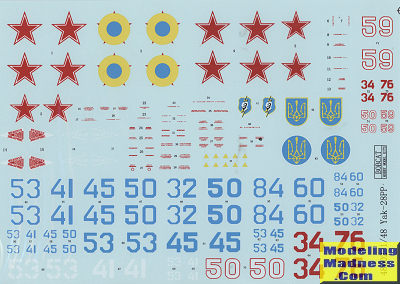
| KIT #: | 48002 |
| PRICE: | $50.00 delivered |
| DECALS: | Two options |
| REVIEWER: | Scott Van Aken |
| NOTES: |

| HISTORY |
The The Yakovlev Yak-28 (Russian: Яковлев Як-28) is a swept wing, turbojet-powered combat aircraft used by the Soviet Union. Produced initially as a tactical bomber, it was also manufactured in reconnaissance, electronic warfare, interceptor, and trainer versions, known by the NATO reporting names Brewer, Firebar, and Maestro respectively. Based on the Yak-129 prototype first flown on 5 March 1958, it began to enter service in 1960.
The aircraft is perhaps best known for the heroic actions of Captain Boris Kapustin and Lieutenant Yuri Yanov after the Yak-28 they were piloting suffered a catastrophic engine malfunction on 6 April 1966. They were ordered to divert to attempt a landing in Soviet zone of Germany, but lost control of the aircraft and strayed into the airspace of West Berlin. The crew managed to avoid a housing estate but crashed into Lake Stößensee without ejecting. Their bodies, along with the wreckage, were raised from the lake by Royal Navy divers (flown in from Portsmouth) and salvage specialists, who also retrieved important top secret material from the plane. This included the engines, which were taken to RAF Gatow to be inspected by RAF and American engineers. The bodies of the two pilots were returned to the USSR with full military honors from both Soviet and British armed service members, and they were both posthumously awarded the Order of the Red Banner. The first engine was recovered on 18 April 1966 and the second a week later; both engines were returned to the Soviets on 2 May 1966.
The Yak-28P was withdrawn in the early 1980s, but trainer and other versions remained in service until after the fall of the Soviet Union, flying until at least 1992. The reconnaissance and ECM aircraft were eventually replaced by variants of the Sukhoi Su-24.
THe Yak-28PP (Izeliye 28PP) (NATO reporting name – "Brewer-E") is the subject of this kit. Deployed in 1970, it is notable as the first Soviet electronic countermeasures (ECM) aircraft. It was unarmed, with an extensive electronic warfare (EW) suite in the bomb bay and various aerials and dielectric panels for transmitting the jamming signals. Excess heat generated by the jamming equipment was dissipated by heat exchangers under the centre fuselage; it did not include a radome. Produced in the 1970s in unknown numbers.
| THE KIT |
 The
Yak-28 has always been a fairly cool looking aircraft in my eyes. It is also
somewhat brutish looking with the long pointy nose and those huge
afterburning engines. As seemingly happens from time to time, Hobby Boss has
also released a couple of Yak-28 kits and they are also the Yak-28PP and the
Yak-28P interceptor. Bobcat also released the interceptor version, but I
wanted the glass nose version and got a good deal on a Facebook sales page
so that is one that bought. I do not know if the Bobcat and Hobby Boss kits
are the same or not, but judging by a recent BarracudaCast resin wheel
replacement set that contains parts that are different for each kit, I'd say
they are not.
The
Yak-28 has always been a fairly cool looking aircraft in my eyes. It is also
somewhat brutish looking with the long pointy nose and those huge
afterburning engines. As seemingly happens from time to time, Hobby Boss has
also released a couple of Yak-28 kits and they are also the Yak-28PP and the
Yak-28P interceptor. Bobcat also released the interceptor version, but I
wanted the glass nose version and got a good deal on a Facebook sales page
so that is one that bought. I do not know if the Bobcat and Hobby Boss kits
are the same or not, but judging by a recent BarracudaCast resin wheel
replacement set that contains parts that are different for each kit, I'd say
they are not.
The molding is excellent and just as we've come to expect from Chinese companies. Thought the parts layout shows two different fuselages, you only get the one for this variant. The cockpit is very nicely done and relies on raised detailing, as there are no instrument decals. It has a nicely done seat and includes levers for the side consoles. The instructions then have you building up the two landing gear assemblies that include the gear bays.
Color information during the build is provided by numbers that refer to the paint chart. Then the nose section is constructed and this includes a lot of small boxes and other bits for the interior sidewalls. One then builds up the wing fuel tanks. There are steps in the instructions on prepping the lower fuselage piece for a display stand, but none is included. You can also skip the step on building the rocket pods as this version didn't use them.
We then move on to building the engines. There are several bits that attach to the outside of these and holes need to be opened to accept them. There are optional open or closed blow-by doors provided. Assembly then moves on to building up the wings. These have separate ailerons and flaps though they are not added until much later in the build process. Bobcat wants you to install the engines prior to attaching the wings. During this time the wingtip 'spikes' are attached.
Next major section is the assembly of the fuselage. This includes installing the landing gear assemblies and the fin/rudder along with the nose assembly and tail cap. Then come the wings and the horizontal stabilizers. While the rudder is separate, the elevators are not. During the final steps the canopy and nose hatch can be posed open or closed. There are also forward fuselage inserts for various ECM antenna housings and the upper spine is attached. Flipping the airframe over, large fuselage air scoops are attached along with the fuel tanks and outriggers. Gear doors are also glued in place and if you want to use them, you have a pair of RATO units that you can build up and attach to the rear.
 Instructions
are nicely drawn, but are quite densely packed with info and can be a bit
confusing in places. Each of the pages is a fold out so one does need to
take care in this regard. Paint references are for Humbrol and Model Master
paints. The instructions provide markings information for at least eight
planes, and you get nose numbers for more than that. Half these planes were
camouflaged and while not in color, the camoflage shades are shown via
various crosshatched and lined sections. A guide provides generic color
information, i.e. dark brown, extra dark green-blue, middle green and other
helpful color info. Decals are very nicely done and provide full stencils.
Fortunately, there are several paint companies that offer sets of
Soviet/Russian colors that should come in handy.
Instructions
are nicely drawn, but are quite densely packed with info and can be a bit
confusing in places. Each of the pages is a fold out so one does need to
take care in this regard. Paint references are for Humbrol and Model Master
paints. The instructions provide markings information for at least eight
planes, and you get nose numbers for more than that. Half these planes were
camouflaged and while not in color, the camoflage shades are shown via
various crosshatched and lined sections. A guide provides generic color
information, i.e. dark brown, extra dark green-blue, middle green and other
helpful color info. Decals are very nicely done and provide full stencils.
Fortunately, there are several paint companies that offer sets of
Soviet/Russian colors that should come in handy.
| CONCLUSIONS |
I can see right from the start that this will be a rather involved build. There are a LOT of small parts and inserts so careful construction will be required. However, if one is careful, a large and impressive model will be the result.
| REFERENCES |
https://en.wikipedia.org/wiki/Yakovlev_Yak-28
December 2020
Copyright ModelingMadness.com. All rights reserved If you would like your product reviewed fairly and fairly quickly, please
contact
the editor or see other details in the
Note to
Contributors. Back to the Main Page
Back to the Review
Index Page
Back to the Previews Index Page